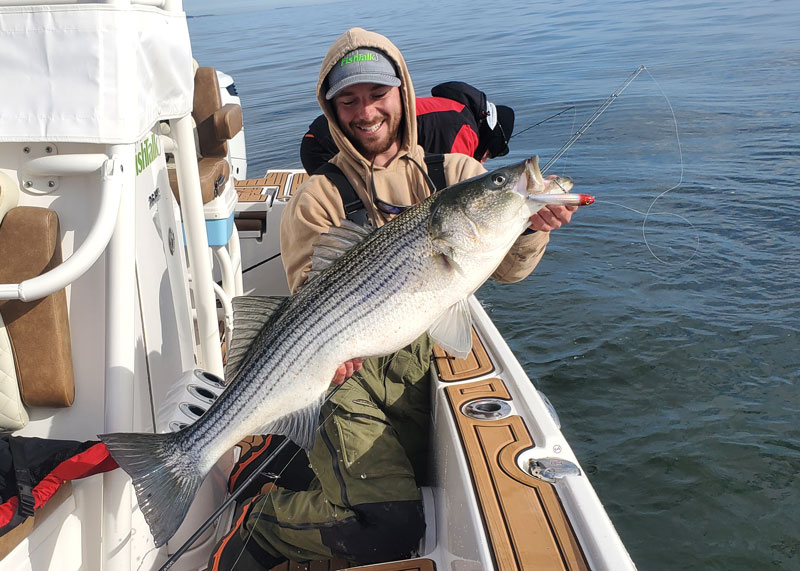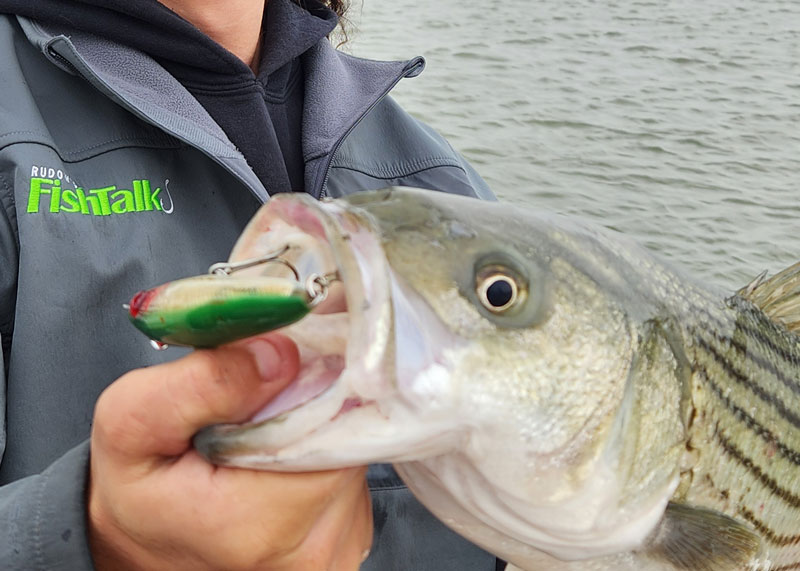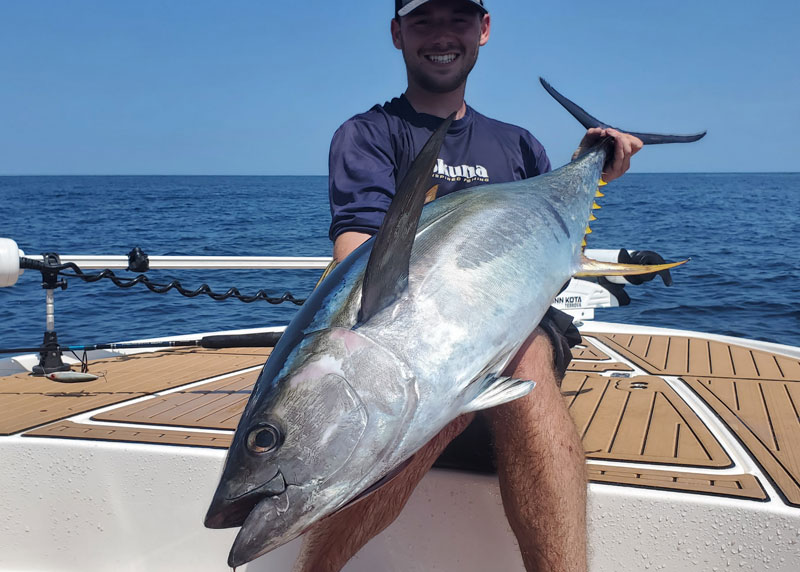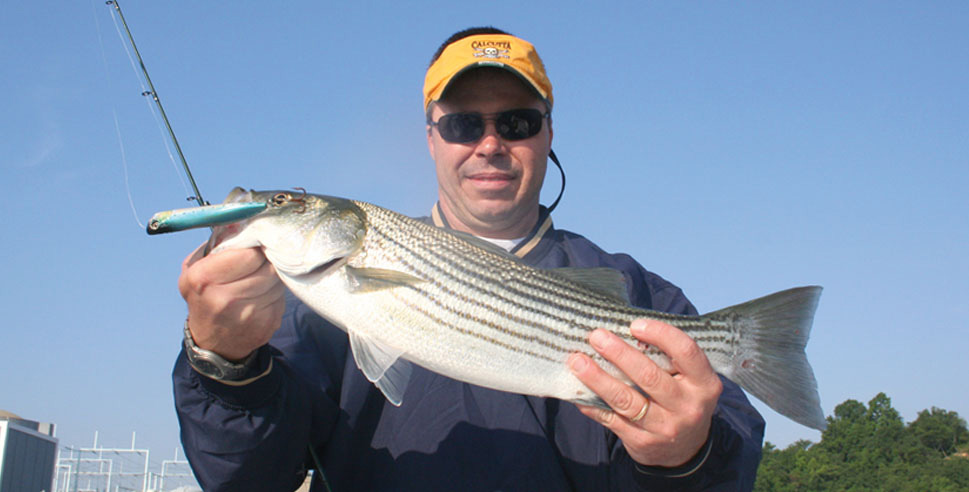Few things get an angler’s adrenaline flowing like a topwater plug under assault. The strike of a surface ambush takes place at the junction between water and air, where you can see, feel, and hear it – and truth be told the moment can be so captivating that many of us fail to set the hook or crank the reel. We’re left standing there slack-jawed, groaning over the missed opportunity while at the same time gasping at the voracious display. If you want sheer fishing excitement, casting topwater plugs can’t be topped.

Plugged In
The first question many people ask when it comes to topwater fishing is which type of plug to use. Everyone has their favorite brands and models, but they can be broken down into several basic categories:
- Chuggers and poppers, which have a concave face and create a loud “bloop!” and a splash when worked across the surface. Examples would include the Storm Chug Bug, Rapala Skitter Pop, and Yo-Zuri 3DR Popper.
- Floating Stick-baits (also called spooks or walkers) which have a torpedo-like face and are used to “walk the dog” (rhythmically pump the rod tip in such a way that the lure zig-zags left and then right as you retrieve it). Examples would include the Bomber Badonk-A-Donk, Heddon Spook, and MirrOlure Top Dog.
- Prop-baits, which use a tiny propeller to create a commotion as they move across the water’s surface. Examples include the Rapala X-Rap Prop, Heddon Torpedo, and Storm Arashi Spinbait
- Unique and unusual, the one-of-a-kind topwater lures that don’t fit into any one category for whatever reason. A good example is Neal Cohen Handcrafted Lures, which have flat angled faces which split the difference between popper and stickbait. Another which has become incredibly popular in recent years is the River2Sea Whopper Plopper, which has a spinning, sputtering tail.
Regardless of body shape, all of these lures commonly have enhancements like fish-attracting rattles, uber-colorful finishes and patterns, and sometimes hair or tinsel teasers tied onto the aft hook.

Which of these should you choose? The right move can change from day to day, and even from tide to tide. There are, however, a few rules of thumb to pay attention to. For starters, most topwater sharpies agree that chuggers, poppers, prop-baits, and other topwater lures that make lots of noise can cause enough of a commotion that they may spook fish (or at the very least, turn them off) in quiet, placid waters. Daybreak and sunset casts to rip-rap and points for striped bass, stealthy searches for speckled trout over shallow weedbeds, and casts into quiet marsh cuts and channels for both species plus redfish are commonly best targeted by walking the dog as opposed to trying to Bloop! the fish in. In rough or open water, however, the opposite is usually true. This is the situation when more noise is often better, and those loud chugs and pops seem to call in fish from afar.
Another specific variable to pay attention to is the competitive level of the fish. When you have a school of stripers breaking water, for example, and the fish are pushing each other out of the way while attacking pods of bait, a big chugger or popper often catches larger fish than other lures cast into the frenzy. We don’t have any scientific insight into why this is the case, but if you keep track of the size of the fish you catch while using a big loud plug in the breakers, you’ll soon realize that more often than not they account for the bigger fish in the cooler.

Topwater Commotion in Motion
Depending on which type of topwater you’ve picked, you’ll want to work it in one of several ways. Stickbaits are the simplest to address, since they get retrieved with the classic walk-the-dog action. The idea is to get the lure “walking” towards the boat by zig-zagging back and forth with a regular, rhythmic cadence. The most effective speed of the cadence will vary depending on conditions, with the general rule of thumb being slower in cooler waters and faster in warmer waters. To get the lure walking, after making your cast reel in any slack line and point your rod tip down towards the water or low and off to the side. You want the line to remain in the water, not raised above it, or the lure won’t zig-zag as well and may end up cartwheeling or hopping out of the water. Then as you reel make short, steady pumps of the rod tip, only a foot or two at most, and watch the lure for zigging and zagging. Try to keep a steady pace, which helps the predators target the lure. If the cadence is irregular because of slack in the line, try reeling faster. If the zigs and zags are minimal, try reeling slower. Watch the stickbait, and settle into a pattern when you see the best walk-the-dog action – or the ensuing blow-ups tell you that you’ve got it right.

When it comes to poppers and chuggers, the one commonality is keeping your rod tip low so that the lure doesn’t jump out of the water. Aside from that, all bets are off. Sometimes the fish like a steady retrieve. At other times stopping a popper mid-retrieve, or every third or fifth pop, and letting it rest for a second or two will generate strikes. Sometimes they respond to a gentle bloop, and other times they like a lot of splash. Experimentation is key. Generally speaking this is also true for propbaits and the oddballs, which can prove most effective with a steady retrieve, but at other times an erratic motion get the fish snapping.
There are a few gear commonalities across the board for using topwater plugs. First off, choose a rod with a slower action than you might use when jigging. Having a noodle tip helps prevent jerking the lure out of the water, and assists in settling into a regular rhythm. Second, this is a job for monofilament. Braid line is likely to cause the lure to go cartwheeling into the air, which not only isn’t attractive to the fish but also creates some nasty tangles. Finally, never use a snap-swivel to attach topwater lures. The weight affects the lure’s balance and doesn’t allow it to ride at the angle it was designed for.

Topwater Plugs and Visual Appeal
Whichever type of topwater you choose, color and size are the next two variables you’ll have to choose between. The first item to keep in mind is that the fish are looking up from below. Those stripes and polka-dots on the lure’s back might look cool to you and me, but in reality, the lure could be jet-black or bright white from the waterline up and the fish wouldn’t know the difference.
Wait a sec – jet black, and bright white? We didn’t use these boring color examples by accident. In fact, these basic colors are the most important to keep on hand. During daylight hours, a white-belly lure is an ideal choice and there are few days when any zany paint jobs will out-fish it. At night and in very low-light conditions the opposite is true, with black usually out-producing the other choices. We’re not saying there will never be a day when the chartreuse-belly plug or the purple guy clearly out-catches the others. But when it comes to topwater, color variables don’t seem anywhere near as important as they are with sub-surface lures.
The second big variable relating to a plug’s appearance is its size. Smaller, four-inch and under plugs will catch a ton of fish, but size does matter when you’re trying to locate the big fish in the crowd. The six-inch range is a good all-around size for topwater plugs in the Chesapeake and its surrounding waters, but if you see a bigger one, get it. A foot-long topwater bait is not too large when you’re trying to target 30-inch-plus stripers, or monster-sized “gator” speckled trout. Will you catch fewer fish throwing one of those logs? You bet – but when the explosion does come, it’ll look like someone tossed a stick of dynamite into the water. Unfortunately topwater plugs this size can be tough to find, so when you see one, grab it.
Setting the Hook with Topwater
When you see a fish explode on your topwater lure the natural reaction is to instantly rear back and set the hook. It'll be tough to resist - very tough - but force yourself to hold back for a fraction of a second. Yank too quick, and often you'll pull the plug right out of the fish's mouth. To hook up as often as possible, when you see the swirl or explosion drop your rod tip back towards the fish, take in a deep breath, and then set the hook. And don't feel bad if you just can't hold back sometimes, because there isn't an angler alive who enjoys complete control 100-percent of the time when there's a topwater explosion.
So: are you ready for a topwater blow-up so violent your plug flies five feet through the air? How about a last-minute boat-side smash that gets you wet? An adrenaline-inducing swirl from the biggest fish in the school? When it comes to exciting strikes like these, topwater simply can’t be beat.
Beginner anglers: be sure to check out How to Fish Topwater Lures for Beginners, to get more insight into the topwater fishing basics.
- Editor's note: this article was originally published in April of 2018 and was last updated in June of 2025.